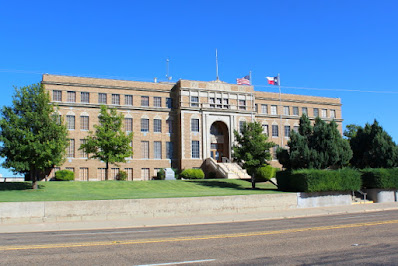Miami (population 597) is the only municipality in Roberts County(Texas) and home of the annual National Cow Calling Championship. I have not called cows since I lived on the farm, but I still remember how to say "Sa Boss."
The County Museum is located in the historic Miami Railroad Depot, which contains a collection of antique furniture, dishes, clothing tools, Indian artifacts, and much more. Located outside of the museum building is an old sod house, windmill, fuel delivery truck, and numerous pieces of farm equipment.
Located just south of Canadian (Texas) is Gene Cockrell's pet dinosaur "Aud," which was named after Gene's wife Audrey. The story goes that Gene spent $2,000 to build the dinosaur so that children traveling north on Highway 83 would know that they were almost home when they saw "Aud."
"Aud" was reported to be 17-feet high and 50-feet long, but I did not hike up the hill to confirm the measurements. (The below picture was taken using a telephoto lens and the hill is a lot taller than it appears to be in the picture.)
Canadian (population 2,649) is located just south of the Canadian River as it passes by the town. The river is a well-known landmark that has been followed by explorers for centuries.
Francisco Coronado followed the Canadian River in 1541 while he was searching for the Seven Cities of Gold. Later, trappers, hunters, and prospectors followed the same trails as Coronado when the were seeking their fortunes in the same area.
When the railroad arrived in the early 1900s, Canadian became a rail and marketing center because of its location.
In 2000, scenes from the Tom Hanks movie Cast Away were filmed south of town at the Arrington Ranch House Lodge. If you saw the movie, this is the ranch where Tom Hanks delivers the unopened FedEx package that he carried with him throughout his ordeal. The ranch is now a bed and breakfast that includes a small museum about the movie.
The first permanent public building in Canadian, and Hemphill County, was a county jail. After the jail contract was issued, it was discovered that the contract was fraudulent. Since the selected builder defaulted on the contract, the citizens had to take legal action all the way to the Texas Supreme Court to resolve the dispute. In 1890 the jail was finally completed and then a few years later a county courthouse was built just east of the jail.
Lipscomb (population 37) was established in 1886 and became the county seat for Lipscomb County. Initially, city lots were sold for $3 per acre. In the first month, seven businesses were started and a hotel was moved to Lipscomb from nearby Dominion. A school was established in one of the church buildings and had 25 students.
The few people that remain in Lipscomb today are proud of the town's heritage. A number of historic building have been restored and now surround the current courthouse that was constructed in 1916.
As I drove through Booker, I could not help but notice the sign that said "Booker Next 9 Exits." I counted the "exits" and there really were 9 streets in Booker (population 1,516) that connected to Texas State Highway 15 as it passed through town.
Museum of the Plains is located in Perrytown and contains some interesting exhibits
Spearman (population 3,368) is home of the J.B. Buchanan Windmill Park. Buchanan collected windmills all of his life and before he passed away in 2003 (age 96) he donated his entire windmill collection to the City of Spearman and the Smithsonian Institution.
There are numerous oil related displays at the Hutchinson County Historical Museum and the petroleum exhibit located directly across the street.
Information at the Quarries site indicates that for thousands of years people mined flint in this area. The oldest mining occurred about 13,000 years ago by the Ice Age Clovis Culture that made spear points used to hunt Columbian Mammoth.
More recently, the Plains Indians mined flint from about 1200 AD to the end of the Indian wars. Flint from the Quarries was a popular trade item throughout the west and Quarry mined flint has been found thousands of miles away at other Indian sites.



































No comments:
Post a Comment